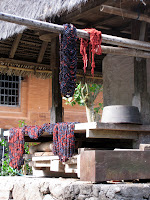The journey started the both sides of the roads showing the handicrafts of the area, furniture, glass and stone-carving, fountains, statuary, (in amazing visual concentration) then on past the village of Celuk which has gold and silversmithing, Batuan village with it's art galleries, and we stopped and looked at Balinese paintings in one shop and bought a kite with dragon design for David to try.
Nearby we donned sarongs to visit the local temple, built in 944, and Batuan Temple has long history. There are many beautiful relief carvings and statues.The gate represents the sacred mountain, and there is the single-leaf like wall in front preventing evil coming in. The right side of the entrance, there is the stage for performances to the gods as offerings, and it is decorated with great reliefs paintings based on the Ramayana.
 |
| Toursits - not us ~ |
We passed through the town named Mas, known for its wood carving. This whole area, though, is thick with artisans and production of handicrafts.
We next stopped at Tenganon, one of few original villages -- known as Bali Aga or Bali Mula -- in Bali. Strategically located in a valley and surrounded by a range of hills and forest, Tenganan village has developed and retained its own way of life. It is best known as the only place where weavers can do a double Ikat, which is a very complex procedure that results in the same pattern on both sides of the cloth. Ikat is a dyeing technique used to pattern textiles that employs a resist dyeing process similar to tie-dye on either the warp or weft fibres.
Bindings, which resist dye penetration, are applied to the threads in the desired patterns and the threads are dyed. Alteration of the bindings and the dyeing of more than one color produce elaborate, multicolored patterns. When all of the dyeing is finished the bindings are removed and the threads are ready to be woven into cloth.
The defining characteristic of ikat is the dyeing of patterns, by means of bindings, into the threads before cloth construction and the weaving of the fabric, takes place. Herein lies the difference between ikat and tie-dye. In tie-dye the fabric is woven first and the resist bindings are then applied to the fabric which is dyed.
In warp ikat the patterns are clearly visible in the warp threads on the loom even before the plain colored weft is introduced to produce the fabric. In weft ikat it is the weaving or weft thread that carries the dyed patterns which only appear as the weaving proceeds. In weft ikat the weaving proceeds much slower than in warp ikat as the passes of the weft must be carefully adjusted to maintain the clarity of the patterns.
Double Ikat is where both warp and the weft are resist-dyed prior to stringing on the loom. Traditionally, and still commonly, a back-strap loom is used, though any variant or modern loom may be used.
High walls surround the village, and marriage to outsiders is frowned upon. The aristocratic Tenganese own large tracts of fertile land, which they hire out to neighboring villagers to farm on a share-cropping basis. A number of unusual rituals take place in this village on special holy days, and once a year there is a ritual blood-shedding fight of pandanus leaves in which all the men of the village prove their manhood. On the main street caged roosters in every color of the rainbow waiting for their next cock fight, but we did not see any while we were there.
We then drove a couple of hours, passing north along the eastern coast of Bali, then passing inland between two volcanoes, 3,000 meter Mt. Agung and much smaller Mt. Seraya, to the eastermost north coast called Amed. Amed refers to a long stretch of coast running from the village of Cucik about 14 km eastwards incorporating the seven villages of Amed,Jemeluk, Bunutan, Lipah, Selang, Banyuning and Aas. The pace of life here is slow and the coastal scenery is stunning.
After a couple of tries, we located a hotel with WiFi, AC, right on the beach for $70 per night, called Life in Amed.
Amed is famous for its beaches, lined with traditional outrigger fishing boats. There is quite coarse black volcanic sand at Amed village beach. As you move further east (and away from Mount Agung volcano), the beaches have softer sand and become more of a mid grey-brown in colour. There is supposed to be good snorkeling, which we will try tomorrow, going out in a small outrigger to the sight of an old wreck. we are apprehensive regarding how we will climb back into the outrigger from the water, as they have no ladder and high sides!






No comments:
Post a Comment